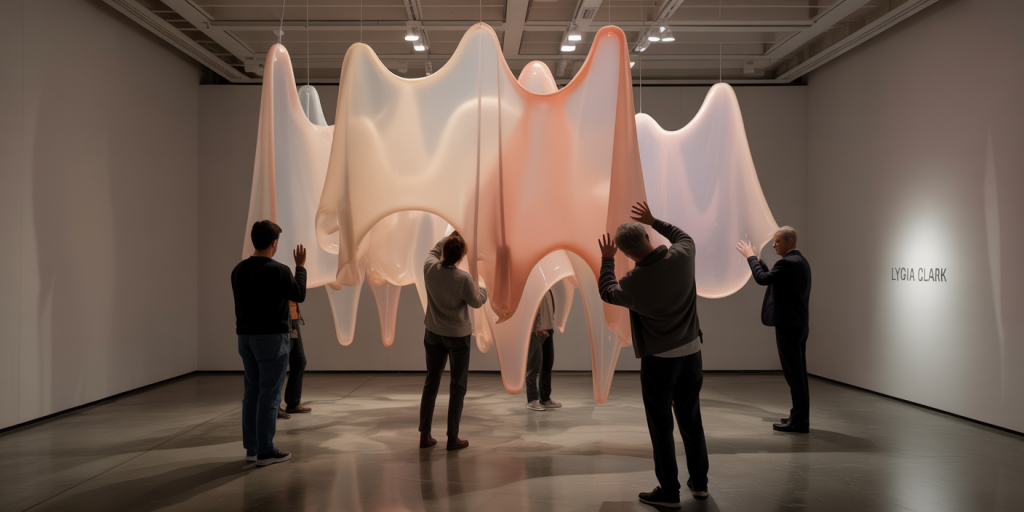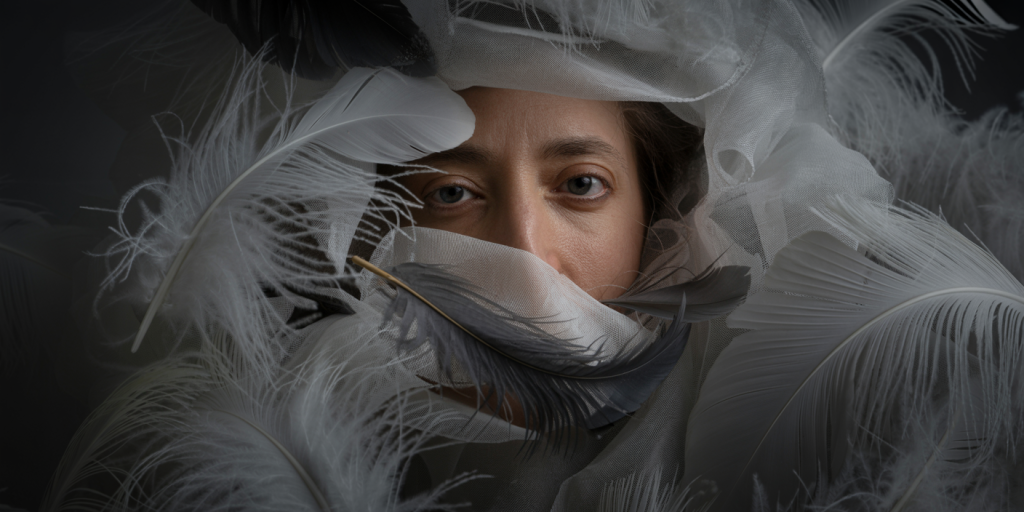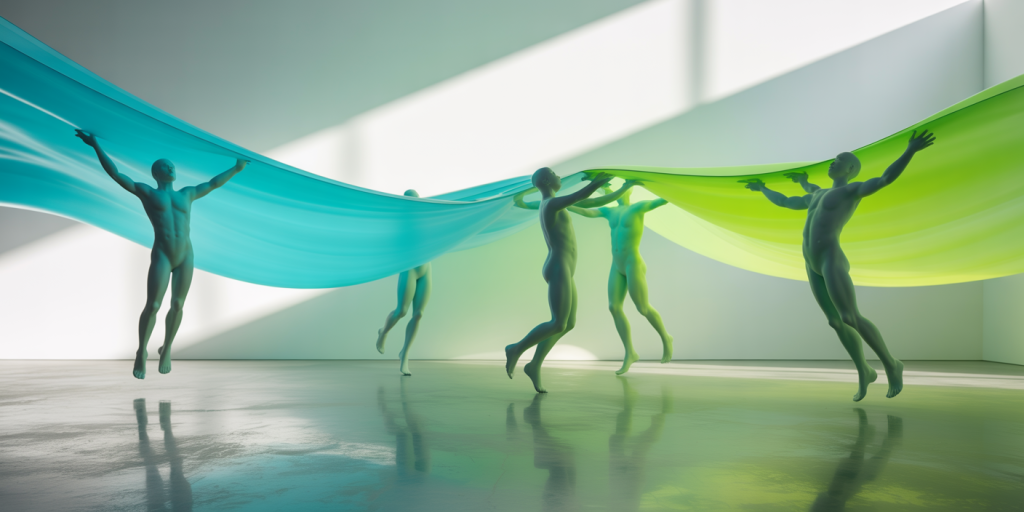Lygia Clark and the Bodies that Unlearn Form
A room breathes. Not with lungs, but with latex. Not with rhythm, but with rupture. Inside, bodies do not move through space – they are unraveled by it. Lygia Clark does not sculpt marble; she sculpts sensation. And in sua obra, the form does not merely bend — it dissolves, implodes, ressurges como um eco do próprio corpo que a toca. Her art is not seen; it is felt in the skin’s memory, in the breath held between touch and estranhamento.
The walls pulse with the memory of touch. Somewhere between therapy and ritual, between object and absence, her work whispers: the body is not a thing — it is a threshold. And thresholds must be crossed, not measured.
Table of Contents
- The Mute Pulse of Materials
- Between Skin and Shadow
- The Silence that Speaks through Latex
- Architecture of Disobedience
- Tactile Labyrinths of the Self
- Rituals of Unlearning
- The Object as Partner
- Bodies Without Center
- Invisible Symmetries
- Form as Fugitive
- The Dissolution of Sculpture
- The Hand that Does Not Hold
- A Topography of Absence
- Therapy or Art?
- The Intimacy of the Strange
- Breathing with the Non Object
- Fragmented Perceptions
- Poetics of Disintegration
- Memory Etched in Flesh
- The Artist as Midwife of Experience
The Mute Pulse of Materials
Clark’s use of rubber, cloth, and plastic breathes a life that classical bronze never could. These are not inert surfaces; they are membranes, thresholds. Latex becomes a second skin — not to cover, but to confront. Her materials pulse without narrative, vibrating with potential contact.
Their silence is not absence but latency — each fold, each tension of fabric, each breath against plastic, is charged with the body that might touch it, press into it, dissolve within it.

Between Skin and Shadow
Clark’s works live between dermis and void. They are shadows made tactile — soft voids that yield to touch but resist meaning. In her ‘Sensorial Masks’, the face becomes both hidden and hyper-exposed, obscured by feathers or sandpaper, velvet or plastic, turning the face into a sensory paradox.
What we touch in these objects is not form, but the ghost of form — a trace. A tactile mirage.
The Silence that Speaks through Latex
The latex in her ‘Bichos’ and therapeutic tools speaks louder than any cast sculpture. Folded, bent, yielded — they are not fixed forms but negotiations. The work exists not in itself, but in what it provokes.
Latex holds silence not as void, but as pressure. Pressure to move, to fold, to listen. Its silence asks questions our eyes cannot answer.
Architecture of Disobedience
Clark’s structures are not built to last. They disobey the permanence of traditional art. Her ‘Relational Objects’ collapse, twist, yield to the body like breath to a mirror. There is no pedestal. There is only touch.
In her hands, architecture becomes fluid, organs without anatomy. The body no longer navigates space — it becomes part of its pliable architecture.
Tactile Labyrinths of the Self
Her works do not lead to aesthetic resolution; they lead us deeper into ourselves. Labyrinths made of elastic bands or enclosed hammocks invite the participant to become explorer and explored.
In these intimate rituals, the skin becomes the map, the compass, the ground. These are not journeys outward, but spirals into embodied memory.

Rituals of Unlearning
Clark proposes not a method but a dismantling — of perception, of posture, of artistic hierarchy. Her works are exercises in unknowing. They demand we unlearn the museum gaze, the distanced contemplation.
They ask us to kneel, crawl, press, inhale. And in doing so, we forget how to look, and begin to feel again.
The Object as Partner
Her objects are never passive. They resist, respond. In ‘The I and the You’, elastic bands connect participants who must move in coordination, transforming the artwork into a relationship.
These are not objects to be admired, but partners in dialogue. The viewer becomes co-creator, entangled in a choreography of empathy.
Bodies Without Center
In Clark’s work, the body loses its anchoring. No longer upright and frontal, it is dispersed — felt through knees, elbows, spine, breath. The center dissolves.
We become bodies not of display, but of perception. Fragmented, reassembled through touch and gesture. A body of becoming.
Invisible Symmetries
There is a hidden symmetry in her work — not of form, but of sensation. One touch leads to another. One motion creates counter-motion. In the invisible web of relations, balance emerges through tension.
Her art speaks in the language of mirrors without reflection, of echoes that answer before we ask.
Form as Fugitive
Form, in Clark’s world, is a fugitive. It slips away the moment we try to define it. Her objects fold, twist, compress, dissolve.
What remains is the residue of interaction. A sculpture that cannot be possessed, only experienced. A ghost of form, more powerful than permanence.
The Dissolution of Sculpture
Traditional sculpture exalts mass, volume, endurance. Clark dissolves all three. Her ‘Bichos’ are metal foldings that respond to touch, never settling into finality.
These are not forms to be viewed, but events to be enacted. Sculpture becomes process — tactile, intimate, uncertain.
The Hand that Does Not Hold
Clark teaches the hand to ungrasp. To touch without seizing. To explore without claiming.
In her work, the hand becomes vulnerable. No longer an instrument of domination, but a seeker of sensation — a blind organ remembering what sight has forgotten.
A Topography of Absence
Absence is sculpted in her installations — the gaps between participants, the invisible tensions in elastic bands, the void beneath the latex. She sculpts what isn’t there.
The participant’s imagination fills the empty spaces. Her works are not complete until we bring our absence to meet theirs.
Therapy or Art?
Her later phase, known as “Structuring of the Self”, blurs the line between therapy and art. But perhaps this is the point: healing is an aesthetic gesture; art is an act of care.
In these interactions, Clark uses objects to guide the participant through self-awareness, not in analysis, but in feeling. It is sculpture as somatic encounter.
The Intimacy of the Strange
Clark’s objects are not comforting. They are often disturbing, alien. Feathers against lips, stones on the chest, water dripping behind the ears. They estrange the body from itself.
But in this estrangement lies a peculiar intimacy. We begin to feel parts of ourselves we’d forgotten. The strange becomes home.
Breathing with the Non-Object
The ‘Non-Object’ is not thing, but process. It exists only when activated by touch, by breath, by presence. Clark’s art is never still — it waits.
It breathes with us, through us. Each interaction is a new sculpture, a new poem made of motion.

Fragmented Perceptions
Clark breaks perception into fragments — of time, sensation, expectation. A piece of rubber, a strip of gauze, a small weight on the chest — each becomes a world.
She teaches us to pause within the instant, to feel the fullness of the fragment. Her work is a meditation on the microcosm of contact.
Poetics of Disintegration
Her legacy is not in forms preserved in galleries, but in the gestures that dissolve within us. Her works disintegrate — not from decay, but from fulfillment.
She leaves us with not artifacts, but experiences. A poetics of vanishing. A memory shaped not in stone, but in skin.
Memory Etched in Flesh
Clark’s art leaves no object behind — only memory. A feather’s tickle. The weight of a rubber tube. The echo of our own breath inside a plastic bag.
These memories are not cognitive. They are etched into muscle, stored in posture, carried in the spine. Her sculpture becomes somatic palimpsest.
The Artist as Midwife of Experience
Clark does not give us images. She births experiences. The artist as midwife — guiding, not controlling. Her role is to create conditions, not conclusions.
She leaves space — literal, emotional, philosophical — for the viewer to become. Her works are not about her. They are about you, us, the moment of becoming.
FAQ – Frequently Asked Questions
Who was Lygia Clark?
Lygia Clark (1920–1988) was a pioneering Brazilian artist known for her groundbreaking contributions to conceptual, participatory, and sensory art. Her career evolved from geometric abstraction to interactive and therapeutic installations.
What are the ‘Bichos’?
The ‘Bichos’ (Creatures) are foldable metal sculptures created in the 1960s. Their structure invites physical manipulation, transforming the viewer into an active participant. Each piece changes shape through touch and never rests in a single form.
What is ‘Structuring of the Self’?
It is a body of work Clark developed in the 1970s–80s, using relational objects for therapeutic and experiential purposes. She considered this practice an extension of art into healing and embodiment.
Was Lygia Clark part of any movement?
Yes. She was associated with the Neo-Concrete Movement in Brazil, which rejected rigid geometric abstraction in favor of more poetic, participatory approaches.
Are her works still exhibited today?
Yes. Many major museums, including MoMA and Tate Modern, exhibit her work. However, due to their interactive nature, many pieces are presented through documentation, while some are recreated for participatory installations.
Is her art meant to be touched?
Absolutely. Interaction is fundamental. Her later works cannot exist without physical and emotional engagement from the viewer.
What influenced her approach?
Clark was influenced by psychoanalysis, phenomenology, bodywork therapies, and Brazilian socio-political contexts. She merged art, healing, and embodiment in a way that defied traditional categories.
Echoes in the Flesh – Final Reflections
Lygia Clark did not sculpt monuments. She sculpted thresholds — fragile, breathing, dissolving forms that invite us to inhabit ourselves anew. Her work speaks not to the eye, but to the spine, the breath, the skin’s invisible archive.
She reminds us that form is not fixed, and neither are we. That the body is not an object in the world, but a question to be asked again and again, through contact, through play, through rupture.
In a world obsessed with permanence, her art dissolves. And in its vanishing, we find something truer: the trace of a hand that never grasped, but always invited.
